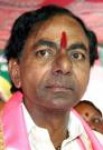The noose is tightened
After banning two TV channels eight months ago, the Telangana chief minister has ordered journalists to get out of the Secretariat.
ALAPATI SURESH KUMAR reports on how media freedom is being eroded in the new state. Pix: K. Chandrasekhar Rao; credit: topnews.in

Telangana Chief Minister, K. Chandrasekhar Rao, has acted against the media again. On 23rd February, his security staff entered the office of his Chief Public Relations Officer in the Secretariat, where reporters normally hang around, and ordered them to get out.
Though it was not out of the blue, the journalists present, representing various print and television organizations, walked out looking dazed.
That it was not a total shock stems from the fact that the Chief Minister of the new state has already limited freedom of expression. The ban on two Telugu news channels, TV9 and ABN Andhra Jyothi, by Multi System Operators (MSOs), has been praised by Rao. The ban is more than eight months old yet the Telangana MSOs Association is not ready to relent and nor is the Rao government ready to intervene.
TV9, aided by the order of the Telecom Disputes Settlement and Appelates Tribunal (TDSAT), has so far managed full visibility in Hyderabad, Mahbubnagar and Khammam districts and a 50 per cent reach in Nizamabad and Adilabad districts. But it is still not being shown in Karimnagar, Warangal, Medak and Nalgonda districts.
ABN Andhra Jyothi also received a favourable order from the TDSAT but it was not applicable to MSOs because the channel had no formal agreements with them. Lately, through some local arrangement, the channel has managed to be seen in some areas which may amount to 15 to 20 per cent, according to sources at the channel.
But the central point is that the ban by the Telangana MSOs Association still holds good eight months later.
However, no one suspected that KCR, as Rao is known, was planning to act against the access that reporters enjoy to the Secretariat. Even his detractors were surprised when, on February 20, it became known that KCR was thinking of ending this access through a leak to some newspapers.
It seems that KCR was unhappy over the presence of a battery of video cameras just outside the entrance to his office. Several Indian Administrative Service (IAS) officers are also believed to have told him that the large number of reporters wandering about made it difficult for them to function. However, when KCR proposed restricting entry to the media, some IAS officers apparently advised against it.
There has been bitter criticism of this decision, not just because it affects journalists’ functioning but because, during the struggle for a separate state, journalists steadfastly backed KCR and his party, the Telangana Rashtra Samithi. Some of these journalists went to the extent of creating a ruckus at press conferences held by the opponents of a separate state, denying them the right to express their views.
After the division of Andhra Pradesh, all Telugu newspapers and news channels created separate bureaus and desks for the two states. It did not surprise anybody when those reporters attached to Telangana bureaus in Hyderabad happened to be from only Telangana.
Now it is they who are finding it very hard to digest KCR’s restriction, particularly as, even at the height of agitation, the entry of journalists was never restricted by the ruling Congress Party even though it opposed the demand for a separate state.
Reacting to the criticism, the Chief Minister met the representatives of journalist unions but confined himself to promising various welfare measures, apart from throwing in some random remarks about how some newspapers were hell bent on creating hurdles to the growth of Telangana.
On February 23rd when agitated journalists who had been asked to vacate the premises at the Secretariat gave vent to their anger by sitting on a dharna, the public relations officials backtracked and denied having given such orders to the security personnel.
Though it is well established by now that KCR brooks no criticism and that his tolerance levels for dissent are slipping, his latest move has caused a commotion. Equally disturbing is that many Telegu news channels have refrained from reporting the protests of journalists.
This was exactly the effect KCR wanted when he blacklisted TV9 and ABN – keep a Damocles sword hanging perpetually over the media. No wonder the majority of Telugu news channels are wary of airing anything which may cause him even the slightest displeasure.
Such articles are only possible because of your support. Help the Hoot. The Hoot is an independent initiative of the Media Foundation and requires funds for independent media monitoring. Please support us. Every rupee helps.
Subscribe To The Newsletter






